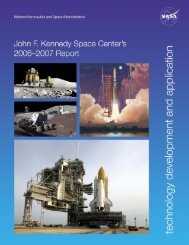Fall-Winter 2008 - Kennedy Space Center Innovative Partnerships ...
Fall-Winter 2008 - Kennedy Space Center Innovative Partnerships ...
Fall-Winter 2008 - Kennedy Space Center Innovative Partnerships ...
You also want an ePaper? Increase the reach of your titles
YUMPU automatically turns print PDFs into web optimized ePapers that Google loves.
the Cryo Crew<br />
been developed for moderate temperatures<br />
and work with industry to redevelop them to<br />
work for cryogenics.<br />
What are aerogels?<br />
Modern aerogels are low-density, solid-state<br />
foams with pore sizes inside the material<br />
typically around 10 nanometers—a true<br />
nano-material that works as the world’s best<br />
thermal-insulating solid. Because of the<br />
unique physical and chemical properties<br />
of aerogels, we can use them to insulate<br />
elements that are impossible to insulate with<br />
conventional materials. In the early 1990s,<br />
I was part of a research project on xerogel,<br />
a very dense structure in the form of a thin<br />
film sealant that solved problems with leaks<br />
in vacuum systems. At the time, vacuumjacketing<br />
of piping and tanks was the only<br />
way to go in cryogenics. However, vacuums<br />
are expensive to effect and maintain, and if<br />
you lose your vacuum, you also could lose<br />
your precious supply of argon or helium. We<br />
needed something more reliable and more<br />
forgiving for a wider range of applications.<br />
So I thought of making a flexible aerogel that<br />
could be used easily in piping designs. This<br />
aerogel turned out to be the answer.<br />
So aerogels are important for your laboratory?<br />
Aerogels were the impetus for starting<br />
the Cryogenics Test Lab. Among my<br />
responsibilities in the 1990s was to test<br />
materials to produce thermal-conductivity<br />
data under cryogenic and vacuum conditions.<br />
We couldn’t do that with aerogels. The<br />
material was too good for the standard<br />
instruments available. I had to find<br />
something that would test its limits under<br />
real-world, actual-use conditions.<br />
So, I invented a machine, Cryostat-1, a<br />
1-meter-tall insulation test instrument using<br />
different vacuum levels and liquid nitrogen<br />
evaporation to measure heat energy. We’ve<br />
since built several improved models in<br />
different configurations for all types of<br />
materials and have four patents for them. Our<br />
cryostats give precise thermal performance<br />
measurements in a simple, economical way.<br />
They can measure a very wide range of<br />
heat leak rates, down to milliwatts, and in<br />
environments ranging from high vacuum to<br />
ambient pressure.<br />
In 1997, I began working with Dr. Stan<br />
Augustynowicz through a <strong>Space</strong> Act<br />
Agreement (SAA) with MVE Inc. (now Chart<br />
Industries). The two of us were a little crazy<br />
about cryogenics, but we had a long-range<br />
vision. And we had this insulation testing<br />
capability to build on. Together, we drafted<br />
a plan for a research testing laboratory that<br />
would be unique, dedicated to cryogenic<br />
applications across the board, and responsive<br />
to people who were working to solve lowtemperature<br />
problems.<br />
If you have worked under SAAs, you must<br />
have been involved with the <strong>Innovative</strong><br />
<strong>Partnerships</strong> Program (IPP), right?<br />
Oh, yes. Our lab got its start with aerogels,<br />
and our work with aerogels got its start<br />
through the IPP’s SBIR (Small Business<br />
Innovation Research) program. In 1992, I<br />
wrote a solicitation for the flexible aerogel<br />
blanket insulation. Aspen Systems in<br />
Marlborough, Massachusetts, responded. We<br />
started a Phase I feasibility study, which led<br />
to a Phase II prototype, and eventually that<br />
work resulted in a spinoff company, Aspen<br />
Aerogels.<br />
We also enter into reimbursable SAAs with<br />
companies that want test data for their<br />
standard materials or that want to develop<br />
new materials for new applications. Anytime<br />
you introduce a new material, you have to<br />
continued on page 9<br />
Barry Meneghelli performs<br />
surface area analysis of an<br />
aerogel material.<br />
volume 1, number 2 | fall/winter <strong>2008</strong> | <strong>Innovative</strong> <strong>Partnerships</strong> Program<br />
5













